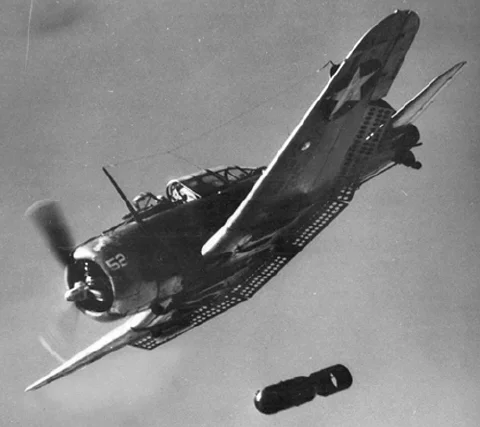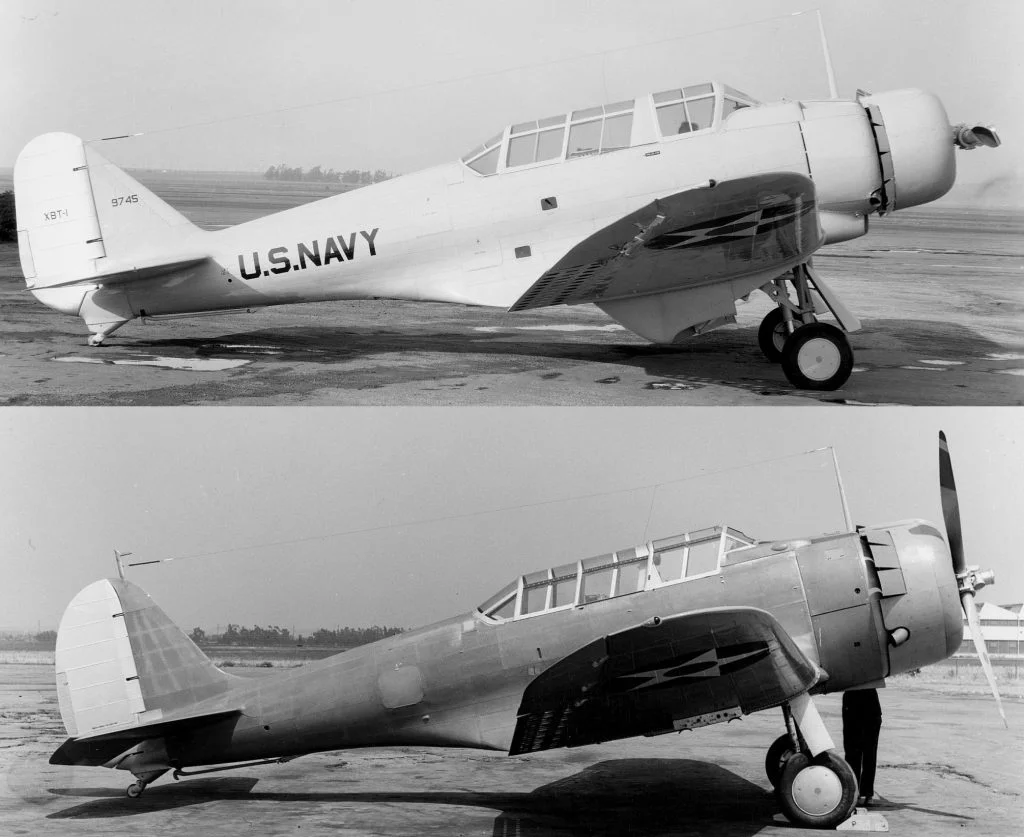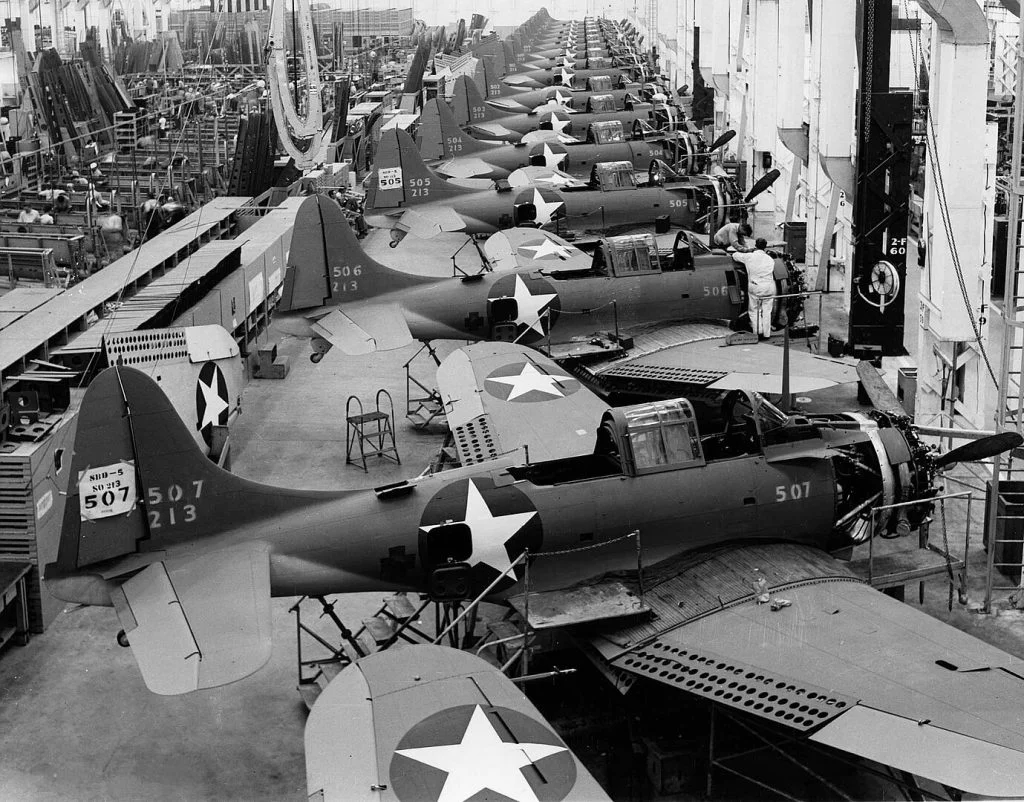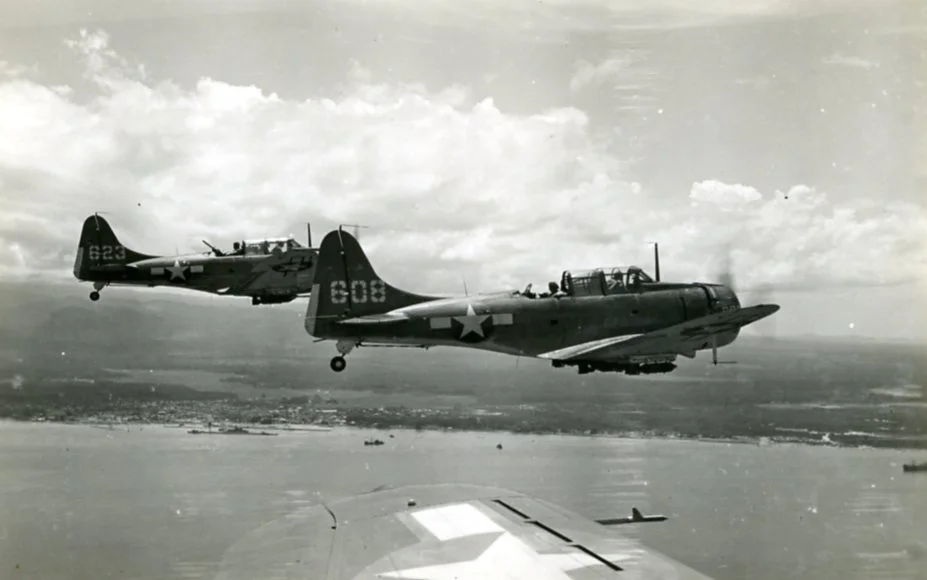
WWII
Douglas SBD Dauntless is a Legendary Dive Bomber
The Douglas SBD Dauntless, a critical component of the U.S. Navy and Marine Corps’ aerial arsenal during the Second World War, showcased the effectiveness and versatility of dive bombers.
With its distinctive design, innovative features, and remarkable combat record, the Dauntless played a pivotal role in numerous Pacific Theater operations, contributing significantly to Allied victories.
Development and Design
The origins of the Douglas SBD Dauntless can be traced back to the mid-1930s when the U.S. Navy recognised the need for a new dive bomber to succeed the ageing Northrop BT-1. This period marked a transformative phase in naval aviation, with innovations rapidly changing aircraft capabilities.
The Navy required an aircraft that could deliver precision strikes against enemy ships and provide reliable reconnaissance over vast ocean expanses.
 The XBT-1 and XBT-2 comparison.
The XBT-1 and XBT-2 comparison.
Ed Heinemann, a distinguished aircraft designer at Douglas Aircraft Company, spearheaded the development of the new dive bomber.
Heinemann’s design philosophy centred on creating a robust, versatile aircraft capable of withstanding the rigours of carrier-based operations. The initial prototype designated XBT-2, built upon the framework of the Northrop BT-1 but introduced several critical advancements.
Dive Brakes
One of the most significant innovations was the inclusion of perforated split flaps, known as dive brakes. These dive brakes allowed pilots to execute steep, controlled dives without experiencing excessive speed buildup, a common issue with earlier dive bombers that often led to structural failures.
The dive brakes enabled precise bomb delivery, making the Dauntless exceptionally effective in its intended role.
Heinemann’s team also focused on enhancing the aircraft’s structural integrity and aerodynamic performance. The SBD Dauntless featured a monocoque fuselage, which provided a streamlined shape and increased durability.
The wings were designed to be both strong and flexible, ensuring they could handle the stress of dive bombing manoeuvres and carrier landings. The aircraft’s all-metal construction, a departure from the mixed-material designs of earlier aircraft, further contributed to its resilience.
 The dive brakes enabled pilots to accurately place their bombs.
The dive brakes enabled pilots to accurately place their bombs.
Powerplant & Armament
The powerplant chosen for the Dauntless was the Wright R-1820-60 radial engine, a reliable and powerful engine that produced 1,200 horsepower. This engine selection was critical, as it provided the necessary thrust for the aircraft’s demanding dive bombing and reconnaissance missions.
The SBD’s engine was paired with a three-bladed constant-speed propeller, optimizing its performance across various flight conditions.
Armament configuration played a crucial role in the design process. The Dauntless was equipped with two forward-firing .50 calibre machine guns mounted in the engine cowling, allowing pilots to engage enemy aircraft and ground targets effectively.
Additionally, the rear cockpit housed two flexible .30 calibre machine guns for defensive purposes, providing protection against attacking fighters.
Bomb delivery was another area where the Dauntless excelled. The aircraft featured a unique swinging trapeze mechanism beneath the fuselage, designed to carry and release a 1,000-pound bomb. This trapeze ensured that the bomb would clear the propeller arc during steep dives, maintaining accuracy and safety.
In addition to the main bomb, the Dauntless could carry two 100-pound bombs on wing racks, increasing its payload capacity and versatility in various mission profiles.
 The armament was significant for an aircraft of this size.
The armament was significant for an aircraft of this size.
Cockpit & Safety
The cockpit design prioritised pilot and gunner efficiency. The layout was ergonomic, with easily accessible controls and instruments that allowed the crew to operate effectively under the stress of combat.
The Dauntless also featured a large, clear canopy that provided excellent visibility, a crucial factor for both navigation and targeting during dive bombing runs.
Heinemann’s attention to detail extended to the aircraft’s survivability. The SBD Dauntless incorporated self-sealing fuel tanks and armour plating around critical areas, enhancing its ability to withstand battle damage and return safely to its carrier or base.
Throughout the development process, rigorous testing and iterative improvements ensured the aircraft met the Navy’s stringent requirements. Prototypes underwent extensive trials, including catapult launches, arrested landings, and dive-bombing tests, to validate their performance and reliability.
 An SBD-3 on the USS Yorktown in 1942.
An SBD-3 on the USS Yorktown in 1942.
The resulting aircraft, officially designated the SBD (Scout Bomber Douglas), represented a significant leap forward in naval aviation technology.
In 1940, the Dauntless entered service, and its innovative design quickly proved its worth in the challenging conditions of the Pacific Theater.
The aircraft’s combination of durability, precision, and versatility made it an indispensable asset to the U.S. Navy and Marine Corps, setting the stage for its legendary combat achievements in the years to come.
Operational History
The Douglas SBD Dauntless first entered service in 1940, just as tensions were escalating in the Pacific. Its early operational history set the stage for its legendary status in World War II.
The aircraft became a symbol of American air power, performing critical roles in numerous battles and contributing significantly to Allied victories.
Early Deployments and Pearl Harbor
Upon entering service, the SBD Dauntless was assigned to various U.S. Navy carriers and Marine Corps squadrons. Its initial deployments involved intensive training exercises to familiarize pilots and crews with its advanced dive-bombing capabilities. This training proved crucial, as the Dauntless soon faced its first test in combat.
The attack on Pearl Harbor on December 7, 1941, saw the Dauntless in action, albeit in a limited capacity. Several SBDs from the carrier USS Enterprise were returning from a scouting mission and found themselves in the midst of the Japanese assault.
Despite the surprise and chaos, these aircraft managed to engage enemy planes and provided some of the few American responses during the attack. Although the Dauntlesses were not able to prevent the devastation at Pearl Harbor, their presence highlighted the need for effective carrier-based aircraft in the Pacific Theater.
The Battle of the Coral Sea
The Dauntless played a pivotal role in the Battle of the Coral Sea in May 1942. This battle marked the first time in history that aircraft carriers engaged each other directly, with their aircraft doing the fighting. SBD squadrons from the carriers USS Lexington and USS Yorktown conducted reconnaissance missions, locating the Japanese fleet.
 A Dauntless over Wake Island. These aircraft were at home in the Pacific.
A Dauntless over Wake Island. These aircraft were at home in the Pacific.
They also participated in bombing raids that inflicted significant damage on Japanese ships, including the carrier Shōhō, which was sunk by coordinated Dauntless attacks.
The Coral Sea engagement demonstrated the SBD’s versatility and effectiveness in both scouting and offensive roles. It also underscored the importance of dive bombers in naval warfare
The Battle of Midway
The Battle of Midway in June 1942 became the defining moment for the Douglas SBD Dauntless. As Japanese forces launched an assault on the strategically crucial Midway Atoll, U.S. Navy carriers USS Enterprise, USS Hornet, and USS Yorktown prepared to counter the attack.
Dauntless squadrons, armed with their precision bombing capabilities, played a decisive role in this engagement.
On June 4, Dauntless aircraft from the Enterprise and Yorktown located the Japanese carrier fleet. Coordinating their attacks, the SBDs achieved remarkable success. Their precision bombing resulted in the sinking of four Japanese carriers: Akagi, Kaga, Soryu, and Hiryu.
 Dropping bombs with the dive brakes out. Photo credit – War Thunder Gaijin.
Dropping bombs with the dive brakes out. Photo credit – War Thunder Gaijin.
Guadalcanal Campaign
Following the triumph at Midway, the SBD Dauntless continued to prove its worth during the Guadalcanal Campaign. Beginning in August 1942, this prolonged and gruelling campaign saw intense fighting as Allied forces aimed to capture and hold the strategically vital island of Guadalcanal.
Dauntless aircraft operated from both land bases and carriers, providing close air support for ground troops, conducting reconnaissance missions, and targeting Japanese supply lines and naval assets.
One notable engagement during the Guadalcanal Campaign was the Battle of the Santa Cruz Islands in October 1942. Despite the USS Hornet being sunk and the USS Enterprise being heavily damaged, Dauntless pilots managed to inflict significant damage on the Japanese carriers Shōkaku and Zuihō.
The SBD’s ability to deliver precise strikes under challenging conditions further emphasized its value to the U.S. Navy’s efforts in the Pacific.
Later Operations and Continued Service
As the war progressed, the SBD Dauntless continued to serve in various capacities across the Pacific Theater. Its roles expanded to include anti-submarine warfare, search and rescue operations, and even night bombing missions.
The aircraft’s rugged design and reliability ensured it remained a critical asset in the ever-changing dynamics of the war.
During the Battle of the Philippine Sea in June 1944, Dauntless aircraft participated in what became known as the “Great Marianas Turkey Shoot,” where U.S. Navy pilots achieved overwhelming success against Japanese aircraft.
Although newer aircraft like the SB2C Helldiver began to replace the Dauntless in frontline service, the SBD continued to perform admirably in secondary roles, including training and reconnaissance.
 A Battle of Midway veteran who later returned to the United States as a carrier qualification training aircraft. Ditched in Lake Michigan while attempting to land aboard USS Sable (IX-81), 1943; recovered from Lake Michigan, 1994.
A Battle of Midway veteran who later returned to the United States as a carrier qualification training aircraft. Ditched in Lake Michigan while attempting to land aboard USS Sable (IX-81), 1943; recovered from Lake Michigan, 1994.
The operational history of the Douglas SBD Dauntless is marked by its significant contributions to key battles and campaigns throughout World War II. Its precision bombing capabilities, versatility, and reliability made it an indispensable asset for the U.S. Navy and Marine Corps.
The Dauntless not only played a pivotal role in achieving tactical victories but also influenced naval aviation tactics and strategy.
By the end of the war, over 5,900 Dauntless aircraft had been produced. Its combat record, particularly at the Battle of Midway, cemented its place in military aviation history.
The lessons learned from the Dauntless’ operations helped shape the development of future naval aircraft, emphasizing the importance of dive bombers in achieving air superiority and supporting ground and naval forces.
Other Nation’s Use
After World War II, the French Navy acquired several Douglas SBD Dauntless aircraft to strengthen its fleet air arm. France received these aircraft under the Mutual Defense Assistance Program, which aimed to rebuild and support the military capabilities of allied nations in the post-war period.
The French Navy integrated the Dauntless into its carrier-based aviation units, utilizing them primarily for training and reconnaissance missions.
French Dauntlesses operated from the aircraft carrier Arromanches (formerly HMS Colossus, which was loaned to France by the United Kingdom).
During the First Indochina War, the Dauntless played a role in providing close air support for French ground forces, although its use was limited compared to newer aircraft. The SBD’s reliability and ease of maintenance proved valuable in the challenging conditions of Southeast Asia.
Royal New Zealand Air Force
The Royal New Zealand Air Force (RNZAF) also operated the Douglas SBD Dauntless during World War II. New Zealand, an important ally in the Pacific Theater, received a number of SBDs to enhance its offensive capabilities against Japanese forces.
The RNZAF integrated these aircraft into its operational framework, using them primarily for training and anti-submarine patrols.
 An RNZAF Dauntless.
An RNZAF Dauntless.
New Zealand’s Dauntlesses did not see extensive combat action, as the RNZAF’s primary strike aircraft were typically Curtiss P-40 Warhawks and later, the Vought F4U Corsairs.
However, the SBDs contributed significantly to the overall training and readiness of New Zealand’s aircrews, ensuring that they were well-prepared for combat operations in the Pacific.
Mexican Air Force
During World War II, Mexico aligned with the Allies and contributed to the war effort by providing military support and resources. The Mexican Air Force, known as Fuerza Aérea Mexicana (FAM), received a small number of Douglas SBD Dauntless aircraft as part of the U.S. Lend-Lease program.
These aircraft were integrated into Mexico’s air defence and coastal patrol units.
Mexican Dauntlesses were primarily tasked with reconnaissance and maritime patrol duties along the country’s extensive coastline. They helped safeguard against potential Axis naval threats and played a role in anti-submarine operations.
The deployment of the SBD in these roles highlighted its versatility and adaptability to various operational requirements.
Service with Chile
Chile, seeking to modernize its air force in the post-war era, also acquired a number of SBD Dauntless aircraft. The Chilean Air Force incorporated these aircraft into its fleet, utilizing them for training and coastal patrol missions.
The Dauntlesses provided a reliable platform for developing the skills of Chilean pilots and enhancing the country’s aerial reconnaissance capabilities.
In Chile, the SBDs were part of broader efforts to build a capable and modern air force. Although they were eventually replaced by more advanced aircraft, the Dauntlesses served as an important transitional asset, bridging the gap between pre-war and post-war aviation technology.
News
The Hanging Temple: China’s 1,500-Year-Old Cliffside Marvel of Faith and Engineering
The Hanging Temple: China’s 1,500-Year-Old Cliffside Marvel of Faith and Engineering Perched precariously on the cliffs of Mount Heng in Shanxi Province, China, the Hanging Temple, also known as Xuankong Temple, Hengshan Hanging Temple, or Hanging Monastery, is an architectural…
The Willendorf Venus: A 30,000-Year-Old Masterpiece Reveals Astonishing Secrets
The Willendorf Venus: A 30,000-Year-Old Masterpiece Reveals Astonishing Secrets The “Willendorf Venus” stands as one of the most revered archaeological treasures from the Upper Paleolithic era. Discovered in 1908 by scientist Johann Veran near Willendorf, Austria, this small yet profound…
Unveiling the Maya: Hallucinogens and Rituals Beneath the Yucatán Ball Courts
Unveiling the Maya: Hallucinogens and Rituals Beneath the Yucatán Ball Courts New archaeological research has uncovered intriguing insights into the ritual practices of the ancient Maya civilization. The focus of this study is a ceremonial offering found beneath the sediment…
Uncovering the Oldest Agricultural Machine: The Threshing Sledge’s Neolithic Origins
Uncovering the Oldest Agricultural Machine: The Threshing Sledge’s Neolithic Origins The history of agricultural innovation is a fascinating journey that spans thousands of years, and one of the earliest known agricultural machines is the threshing sledge. Recently, a groundbreaking study…
Nara’s Ancient Sword: A 1,600-Year-Old Protector Against Evil Spirits
Nara’s Ancient Sword: A 1,600-Year-Old Protector Against Evil Spirits In a remarkable discovery that has captured the attention of archaeologists and historians alike, a 7.5-foot-long iron sword was unearthed from a 1,600-year-old burial mound in Nara, Japan. This oversized weapon,…
The Inflatable Plane, Dropped Behind the Lines for Downed Pilots
Experimental The Inflatable Plane, Dropped Behind the Lines for Downed Pilots The Inflatoplane from Goodyear was an unconventional aircraft developed by the Goodyear Aircraft Company, a branch of the renowned Goodyear Tire and Rubber Company, also famed for the Goodyear…
End of content
No more pages to load











